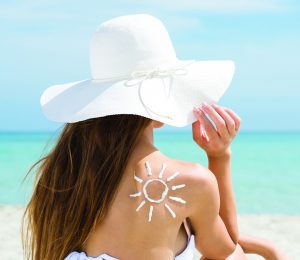By Jacqueline Thomas, D.O., Board Certified Dermatologist
 Summer is fast approaching and with it comes relaxation and fun in the sun. It is important to keep your skin healthy this summer and all year because anyone can get skin cancer, regardless of skin color.
Summer is fast approaching and with it comes relaxation and fun in the sun. It is important to keep your skin healthy this summer and all year because anyone can get skin cancer, regardless of skin color.
In most parts of the country, the hottest part of the day is from 10AM to 2PM, (11AM to 3PM during daylight savings time). In southwest Florida, the sun is more intense for a longer duration from 9AM to 4PM. The American Academy of Dermatology recommends a tip that if your shadow appears shorter than you, it is time to seek shade or sun protection. Sun protection is one way to help prevent skin cancer. It is important to remember to use a sunscreen with a sun protection factor, or SPF, of 30 or higher labeled as broad spectrum which confers both UVA and UVB protection. Sunlight gives off ultraviolet rays or ultraviolet radiation in two types: UVA and UVB. Both UVA and UVB exposure accelerate cellular damage, ageing and skin cancer. It is also recommended for use to be applied to sun exposed skin every two hours while outdoors.
Sunscreen approved by the FDA have now changed their labels. Terms such as “all-day protection,” “waterproof” and “sweat-proof” are no longer approved by the FDA. The new labels identify time limitations such as 40 minutes or 80 minutes. One may find a label indicating the sunscreen product to have a water-resilient formulation with the packaging stating “water resistant (40 minutes).”
Many people question the type of clothing that would best protect the skin. The mainstay is to wear long sleeve shirts, pants, sunglasses, and hats with a 3 inch or wider brim. Dark colored and tightly woven fabrics such as denim or velvet offer greater ultraviolet protection factors (UPF) than loosely woven lighter colored fabrics. Many believe they are adequately protected if they are sitting in the shade. Although the sun may not be directly hitting the skin straight on while shaded or on cloudy days, ultraviolet light from the sun is reflected off of surfaces such as water, sand, concrete, and snow then scattered and adds to the total ultraviolet radiation exposure.
Erroneously, many patients believe if they are driving a car or indoors next to a window, they are protected from the ultraviolet radiation exposure from sunlight.
UVA rays can penetrate through glass and windows. Therefore, if driving or sitting near a window, apply a sunscreen with the broad spectrum labeling to include the protection from UVA coming through glass.
Several studies have estimated the average consumer uses 25%-50% of the amount the FDA tests to achieve 2mg/cm2 thickness density resulting in a lower SPF than on the product label. Therefore, most consumers do not use enough of a quantity (about 1 ounce) of sunscreen in one application while thinking they are getting the desired SPF. One rule of thumb, is to apply a golf ball-
sized amount into the palm and rub all over the exposed skin. This same amount is recommended to be applied every two hours while exposed.
When outside in the morning with an adequate amount of sunscreen used, remember to re-apply when going outside later in the day if more than two hours have elapsed since first use.
1 in 5 Americans will be diagnosed with skin cancer in their lifetime. Avoid tanning beds, they can cause skin cancer, dark spots, light spots and wrinkling. Get your skin checked annually. Remember to keep your skin healthy and youthful this summer.
To schedule your appointment, please call 239-348-4221









